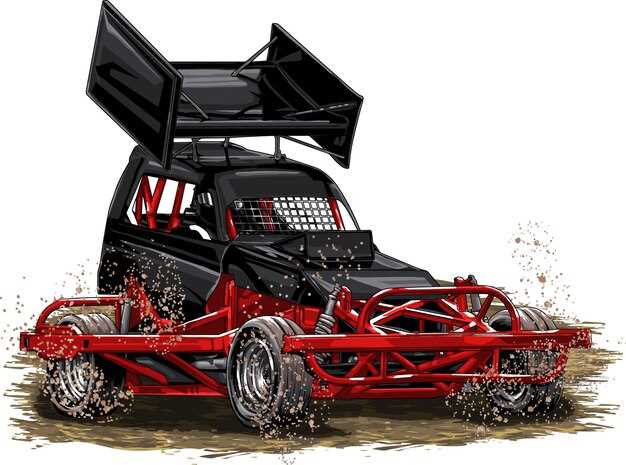
When it comes to maximizing performance in drift car builds, the suspension setup plays a pivotal role. A well-tuned suspension allows drivers to achieve the ideal balance between grip and slide, enabling them to navigate corners with precision while maintaining control. By focusing on the nuances of this setup, enthusiasts can elevate their drifting experience and ultimately improve their driving skills.
The choices made during the car build process directly impact how effectively a vehicle can drift. Selecting the right components, from coilovers to sway bars, is essential for achieving the desired handling characteristics. Furthermore, understanding the dynamics of weight transfer and suspension geometry can lead to significant improvements in a car’s drifting capabilities.
In this article, we’ll explore various power techniques and practical tips for optimizing your drift car’s suspension setup. Whether you’re a seasoned drifter or just starting out, these insights will help you make informed decisions that enhance your vehicle’s performance on the track.
Drift Car Builds: Suspension Power Techniques and Tips
When it comes to drift car builds, the suspension setup plays a crucial role in achieving optimal performance and control during drifts. The main goal is to achieve a balance between stability and responsiveness, allowing the driver to maintain control while pushing the limits of their car.
Suspension geometry is fundamental to a successful drift setup. Adjusting the camber, caster, and toe angles can significantly enhance tire contact with the road during a drift. A slight negative camber can increase tire grip, improving cornering ability, while proper toe settings can help the car stay planted during transitions.
Upgrading to a coilover suspension system provides adjustable ride height and damping settings, enabling drivers to fine-tune their setup based on track conditions and personal preferences. Softer damping settings can enhance grip on bumpy roads, while stiffer settings are ideal for smooth surfaces, allowing for quick weight transfer during drifts.
Additionally, anti-roll bars play a significant role in drift car suspension. Stiffer bars will reduce body roll, improving responsiveness and cornering stability. However, it’s essential to find the right balance, as overly stiff settings can lead to a loss of traction, especially in tight corners.
Proper weight distribution is another critical aspect of a successful drift setup. Placing more weight on the rear of the car can help initiate drifts more easily. This can be achieved by relocating the battery or using a lighter front-end component. Understanding how weight shifts during braking and acceleration can help drivers master the art of drifting.
Finally, regular maintenance and checks on suspension components are essential for consistent performance. Worn out parts can lead to unpredictable handling, so investing in quality bushings and ensuring alignment is crucial for maintaining the ideal drift setup.
Choosing the Right Suspension Components for Drift Cars
When building a drift car, selecting the appropriate suspension components is crucial to optimize performance and handling. The right setup will enhance your ability to control the vehicle during drifts while maintaining stability and grip.
There are several key components to consider when assembling your drift car’s suspension system:
| Component | Function | Tips |
|---|---|---|
| Coilovers | Provides adjustable ride height and damping | Opt for adjustable coilovers to customize stiffness and height for various conditions. |
| Sway Bars | Improves handling by reducing body roll | Consider thicker sway bars for enhanced responsiveness during cornering. |
| Control Arms | Helps maintain wheel alignment under load | Invest in aftermarket control arms for greater camber and toe adjustments. |
| Bushings | Reduces friction and absorbs shocks | Upgrade to polyurethane bushings for better response and durability. |
| Shock Absorbers | Dampens oscillations and improves comfort | Select shocks with adjustable damping settings to fine-tune your setup. |
Each suspension component plays a vital role in the overall setup of the drift car. Proper selection and tuning can greatly influence how the car handles during drift scenarios. Testing and adjustments are essential to find the perfect balance for your driving style and track conditions.
Tuning Shock Absorbers for Optimal Drift Performance

When it comes to achieving the best drift performance for your car, tuning shock absorbers is a critical aspect of the suspension setup. Properly adjusted shock absorbers help maintain control during high-speed corners and transitions, ensuring that the tires stay planted for maximum grip.
Here are essential steps and considerations for tuning shock absorbers for drift:
- Understand Shock Absorber Types:
- Monotube: Offers better heat dissipation and response, ideal for high-performance situations.
- Twin-tube: Generally more affordable and provide a smoother ride; may not perform as well under extreme conditions.
- Adjust Compression and Rebound Settings:
- Compression: Tighter settings prevent the car from bottoming out on hard drifts.
- Rebound: Adjust to keep the tires in contact with the road after a bump, preventing excessive bouncing.
- Consider Ride Height:
- A lower ride height can lower the center of gravity, enhancing stability during drifts.
- A balance must be struck to avoid bottoming out while also maintaining adequate ground clearance.
- Spring Rate Adjustments:
- Select stiffer springs to reduce body roll during drifts, enhancing control.
- Customize spring rates based on the car’s weight distribution and intended use.
- Testing and Fine-Tuning:
- Conduct testing sessions to gather feedback on suspension performance.
- Make incremental adjustments and note changes to improve the setup continuously.
In summary, tuning your car’s shock absorbers is fundamental for optimal drift performance. A well-balanced suspension setup not only improves handling but also enhances the overall drift experience. Pay attention to your adjustments and always aim for a setup that complements your driving style and the specific characteristics of your vehicle.
Understanding Camber and Toe Adjustments in Drift Setup

In the world of drift car builds, suspension tuning is crucial for achieving optimal performance. Among various adjustments, camber and toe play significant roles in how a vehicle handles during a drift. Understanding these settings can help you fine-tune your setup for better stability, tire wear, and overall control.
Camber refers to the angle of the wheels in relation to the vertical axis when viewed from the front or rear of the car. Negative camber, where the top of the wheel tilts inward, is beneficial for drift setups as it enhances cornering grip. This angle allows the tires to maintain better contact with the road surface during aggressive cornering, promoting increased traction. However, it’s essential to strike the right balance; excessive negative camber can lead to uneven tire wear and reduced straight-line stability.
Toe settings determine the direction in which the wheels point relative to the car’s centerline. There are two primary types: toe-in and toe-out. Toe-in means the front of the wheels is closer together than the rear, providing stability at high speeds, which is essential for drift scenarios where control is vital. On the other hand, toe-out, where the front of the wheels is farther apart, can enhance responsiveness and quick direction changes, beneficial for initiating drifts. Finding the perfect toe setting can significantly impact the vehicle’s responsiveness and predictability during a drift.
When adjusting camber and toe, consider the specific driving conditions and your personal driving style. Each driver may prefer different settings based on factors such as track layout, weather conditions, and tire characteristics. Testing various configurations during practice runs will help you identify the ideal setup for your drift car.
In conclusion, mastering camber and toe adjustments is essential for optimizing your drift car’s performance. Properly tuned suspension settings will not only improve your control during drifts but also enhance tire longevity and overall car behavior on the track.
Impact of Ride Height on Drift Handling and Stability
Ride height plays a crucial role in the overall setup of a drift car, affecting handling characteristics and stability during maneuvers. Lowering the ride height can significantly enhance the vehicle’s center of gravity, enabling improved cornering performance and faster weight transfer during drifts. A lower center of gravity helps the car maintain better control and reduces body roll, allowing drivers to execute sharper turns with precision.
Conversely, raising the ride height may introduce unforeseen consequences. While a higher stance can provide increased ground clearance, it can lead to a higher center of gravity, resulting in increased body roll and reduced stability. With a taller setup, the car might become less predictable during aggressive steering inputs, making it essential to find an optimal balance that suits individual driving styles.
Additionally, ride height impacts suspension geometry. Changes in height can alter camber and toe angles, affecting tire contact patches and grip levels. For drift setups, achieving the right camber angle is vital; proper alignment ensures the tires maintain maximum contact with the road during dynamic drifting scenarios.
It is essential to consider the type of drifting intended when setting ride height. For example, competitive drift events may require a lower ride height for better performance on smooth tracks, while street drifting might benefit from a slightly higher setup to accommodate varying road conditions. Ultimately, finding the ideal ride height involves a combination of experimentation and refinement, allowing drivers to tailor their car setup for optimal drift handling and stability.
Installing Upgrade Kits: What You Need to Know
Upgrading your car’s suspension is essential for enhancing performance, especially in drift setups. The right upgrade kit can dramatically improve handling, stability, and responsiveness during maneuvers. Here are key considerations for a successful installation.
1. Choose the Right Kit: Select a suspension upgrade kit that complements your driving style and car setup. Research various options, including coilovers, sway bars, and bushings, ensuring compatibility with your vehicle. Reading reviews and comparing specifications can help you make an informed decision.
2. Necessary Tools and Equipment: Before starting the installation, gather all necessary tools such as wrenches, jacks, and torque wrenches. A clean and organized workspace is crucial for efficiency and safety during the process.
3. Installation Process: Follow the manufacturer’s instructions meticulously. For most kits, the process involves removing the existing suspension components, preparing the new parts, and carefully installing them. Take your time to ensure all fasteners are secured to the recommended torque specifications to prevent any future issues.
4. Alignment and Testing: After installation, professional wheel alignment is vital. Misalignment can lead to uneven tire wear and compromised handling. Following alignment, take your car for a test drive, checking for any unusual noises or performance issues. Make adjustments as needed to fine-tune the setup.
5. Maintenance and Upkeep: Regularly inspect your upgraded suspension components for signs of wear or damage. This proactive approach will help maintain optimal performance and prolong the life of your upgrades.
By considering these factors when installing suspension upgrade kits, you can enhance your car’s drift setup and enjoy improved handling dynamics on the track.
Maintaining and Troubleshooting Your Drift Car Suspension
A well-setup drift car suspension is crucial for achieving optimal performance during drifting. Regular maintenance and troubleshooting can prevent costly repairs and ensure your vehicle performs at its best. Start with routine inspections of all suspension components, including shocks, struts, bushings, and arms. Look for signs of wear, such as leaks, cracks, or excessive play. Addressing these issues early will help maintain the integrity of your suspension setup.
Pay attention to the alignment settings of your drift car, as improper alignment can lead to uneven tire wear and unpredictable handling. Camber, caster, and toe adjustments should be regularly checked and recalibrated based on your driving style and track conditions. A good starting point for drift alignment may be negative camber on the front wheels and zero or slight toe out for improved steering response.
When troubleshooting suspension problems, listen for unusual noises while driving. Clunks or rattles may indicate loose components or worn-out bushings. After identifying problematic areas, replace any damaged parts promptly to maintain your suspension’s overall performance. Additionally, ensure that your coilover systems are properly set up. Adjust spring rates and damping settings to match your driving style and track requirements, achieving the right balance between comfort and performance.
Lastly, perform regular inspections on your tires and wheels, as they directly impact your suspension’s effectiveness. Ensure that tire pressure is maintained, and rotate tires regularly to promote even wear. A well-maintained tire setup will enhance grip and stability, ultimately contributing to a more controlled and enjoyable drifting experience.
